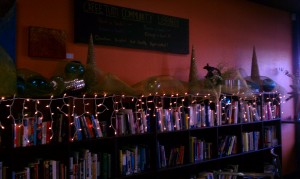
Mega-bestselling author Debbie Macomber at the San Antonio Express-News Book and Author Luncheon, which I crashed. (Photo by Kin Man Hui/San Antonio Express-News)
Lunch usually consists of me at my desk with a trusty pb&j. But last month I got to attend the San Antonio Express-News Book and Author Luncheon.
What a treat.
The event raises money for the clinical research program at the Cancer Therapy & Research Center at the UT Health Science Center San Antonio.
Each year six fantastic authors come to the event, where I’m sure they are astonished to see 1,100 people cramming into lines to buy books so they can have them signed. Viva la old media!
Here are some of the little tidbits I scribbled in a notebook – a reporter’s habit. I can’t listen to someone speak without taking notes, even when I’ve just been invited to sit at the company’s extra seat and enjoy. It’s a disease.
Most of what caught my ear had to do with how the authors found their way into the writing life.
Terry Thompson-Anderson, author of the new “Texas on the Table: People, Places and Recipes Celebrating the Flavors of the Lone Star State,” spent three years and drove 30,000 miles researching her latest cookbook. But she didn’t learn to cook until a talented mother-in-law taught her. Anderson said she thought she would have a totally different life path. She expected when she got out of college that she would write the Great American Novel straightaway. Easy.
“Before we can be old and wise we must be young and stupid, as was the case,” Anderson said.
Dana Sullivan was the creative director for Costco, a position that many people likely would settle into and just wait for retirement to roll around. But Sullivan itched to do something else – illustrating and writing books. It seemed impossible.
But he had good inspiration in his own family. His son had done some things that others might find crazy. He dropped out of school and worked to save money to go do worthy work in Africa. Then when his son came home from Kenya, he announced that what he really wanted to do was become a cowboy. Which despite having zero experience, he did immediately.
Sullivan, meanwhile, said he had thrown “the usual barriers” in front of his own dreams: “home, family, fear.”
“Your dreams are not always lighted with a path,” Sullivan said. He ultimately screwed up the courage to leave his job and decided to try finding that path anyway. “This was 2008. What could possibly go wrong?” he asked.
Despite horrible timing, Sullivan has since published “Ozzie and the Art Contest” and illustrated author Judy Young’s “Digger and Daisy Go on a Picnic” with author Judy Young. Sullivan’s new books are “Kay Kay’s Alphabet Safari” (inspired by a Kenyan orphanage, where some of the proceeds go) and “Digger and Daisy Go to the Doctor.”
Debbie Macomber, best-selling author of a jillion books (OK, 150 and counting. Honestly, when does she sleep?), said she was always inspired by a cousin who died very young from cancer.
If you have a dream, you don’t have much time to chase it. Hurry!
“You cannot push your dream into the future,” Macomber said. “If you want to be a writer, start now.”






